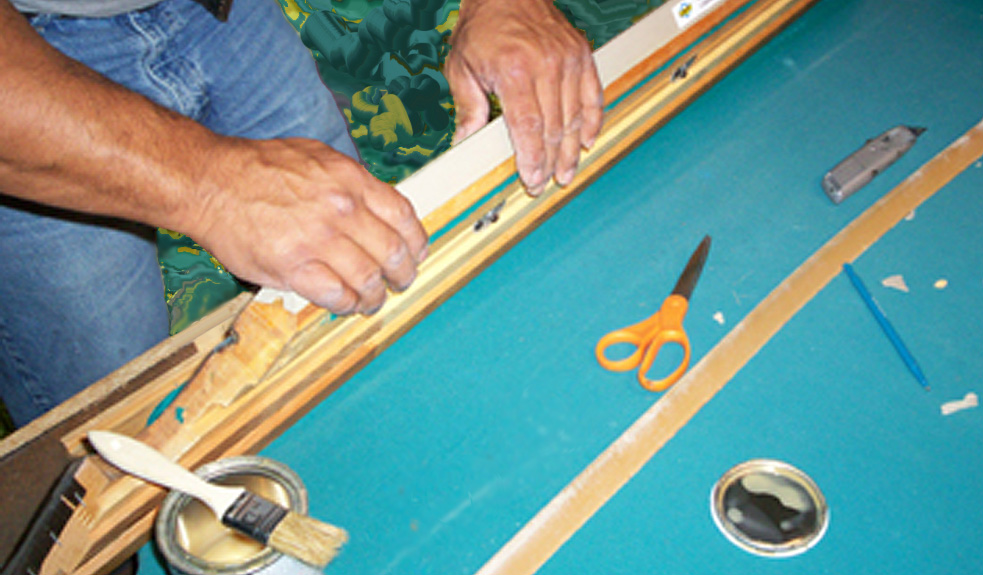Knowing when to replace your pool table cushions is essential for maintaining the best possible game play.

Here are some clear signs and steps you can use to determine if it’s time to replace them:
1. Check the Bounce
One of the most straightforward tests you can perform is the “bounce test”:
- Method: Drop a ball from about eye level (or around 30 inches) onto the cushion.
- Expected Result: The ball should bounce up and nearly reach its original height if the cushions are in good condition.
- Indicator of Replacement: If the ball doesn’t bounce back up to at least two-thirds of its original height, the cushions might be dead and need replacing.
2. Listen to the Sound
- Method: Listen to the sound the ball makes when it hits the cushion. A healthy cushion should produce a resilient and somewhat muffled thud.
- Indicator of Replacement: A “flat” or “slapping” sound indicates that the cushions are no longer providing the proper resistance and could be hardened or deteriorated.
3. Feel the Cushions
- Method: Press down on the cushions in various places along the rail.
- Expected Texture: They should feel firm and uniform throughout.
- Indicator of Replacement: If they feel uneven, hard, or there are noticeable depressions, it’s likely time for them to be replaced.
4. Inspect for Physical Damage
- Method: Look for any visible signs of wear and tear, such as cracks, tears, or peeling.
- Indicator of Replacement: Physical damage can significantly affect play quality and usually means the cushions need to be replaced.
5. Consider the Age
- General Rule: Pool table cushions are generally expected to last between 5 to 15 years, depending on their quality, material, and the amount of play the table sees.
- Indicator of Replacement: If your cushions are older than this, consider checking them using the above methods to determine if they need replacing.
6. Professional Opinion
If you are unsure about the condition of your cushions after performing these tests:
- Action: It can be wise to have a professional pool table mechanic look at them. They can provide a more detailed analysis and replace the cushions if necessary.
By keeping an eye on these factors and regularly testing your pool table’s cushions, you can ensure that your game remains at its best and avoid any unexpected issues during play.
Selecting Pool Table Cushions
When you’re looking to replace the cushions on your pool table, selecting the right type is crucial for maintaining the integrity of gameplay and ensuring durability.
Here are some key factors to consider to help you choose the best cushions for your pool table:
1. Material Quality
- Rubber Types: The quality of the rubber is pivotal. K-66 profile rubber is commonly used for standard tables as it provides consistent bounce and longevity. Higher quality options like K-55 or U23 profiles might be available depending on the manufacturer. These provide a different type of bounce and might be preferred by more experienced players.
- Natural vs. Synthetic Rubber: Natural rubber generally offers better elasticity and aging characteristics compared to synthetic versions, which means better playability and durability.
2. Profile and Size
- Match to Table Size: Make sure the profile of the cushion matches your table type. Different profiles affect the ball’s rebound speed and angle.
- Standard Profiles: For example, American pool tables often use K-66 cushions, which are taller and provide a slower, more controlled bounce. Snooker tables use an even narrower profile like L-shaped cushions.
- Check Specifications: Always check the manufacturer’s specifications for size and profile recommendations for your specific table.
3. Brand Reputation
- Reputable Brands: Opt for cushions from well-known and reputable brands in the billiards industry. Brands like Simonis, Brunswick, and Olhausen offer high-quality materials that last longer and perform better.
- User Reviews: Look at online reviews and forums to see what other players recommend based on their firsthand experiences with various brands and types.
4. Consistency
- Uniform Density: The cushions should have a uniform density that provides consistent bounce along the entire length of the rail.
- Test Reports: Some brands will provide test reports showing the consistency and rebound qualities of their cushions.
5. Age Resistance
- Check for Age Resistance: Good quality cushions are designed to resist hardening and decomposition over time. This is particularly important in environments with varying temperatures and humidity levels.
- Guarantees/Warranties: Manufacturers often offer guarantees on their products, which can be a testament to their durability and quality.
6. Price vs. Quality
- Investment: While it might be tempting to go for cheaper options, investing in higher-quality cushions will save money in the long run as they need to be replaced less frequently and offer better playability.
- Balance Your Budget: Consider your budget and how much use your table gets. If you play frequently or competitively, it might be worth investing in higher-end cushions.
Removing & Replacing Pool Table Cushions
See how it’s done here… and here…
